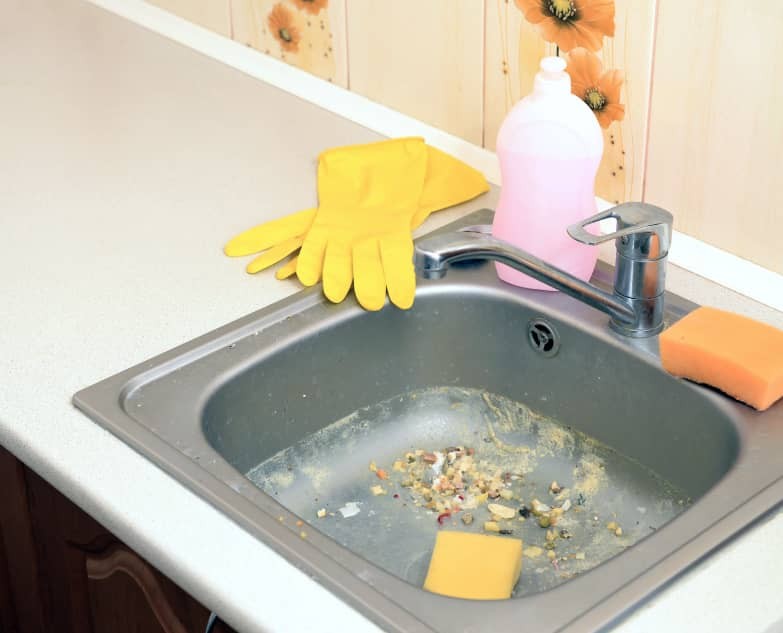Garbage disposals offer a convenient way to manage food scraps, but clogs can lead to unpleasant odors and standing water. Fortunately, you can usually clear these clogs yourself with a few simple tools. This guide will provide comprehensive steps on How To Unclog A Food Disposal effectively.
Understanding Why Your Food Disposal is Clogged
Food disposals are designed to grind food waste, allowing it to be flushed down the drain. However, several factors can contribute to clogs:
- Insufficient Water Use: Disposals require a steady stream of water to properly carry away ground food waste. Running the disposal without enough water can cause food particles to accumulate and clog pipes.
- Hot Water Usage: Surprisingly, hot water can worsen clogs. It melts fats and oils, allowing them to coat the disposal blades and pipe walls, leading to blockages.
- Overloading the Disposal: Disposals work best when processing small amounts of food in batches. Overloading can overwhelm the system and cause jams.
- Grinding Problematic Foods: Some foods are notorious for causing clogs. Avoid putting eggshells, coffee grounds, potato peels, banana peels, and fibrous vegetables down the disposal. These items can clump together and obstruct pipes.
- Lack of Regular Cleaning: Inconsistent cleaning allows grease and food residue to accumulate, leading to clogs. Regular cleaning with a suitable disposal cleaner is essential.
Step-by-Step Guide to Unclogging Your Food Disposal
Even with regular maintenance, clogs can still occur. Here’s a detailed guide on how to unclog and clean a food disposal:
Essential Supplies:
- Garbage disposal cleaner tablets (recommended)
- Paper towels or cloth rags
Necessary Tools:
- Flashlight
- Channel-lock pliers
- Tongs or long-reach pliers
- Bucket
- Scrub brush or wire
Safety First: Always consult the appliance and product manuals before beginning any task.
Step 1: Disconnect Power
Ensure the disposal is switched off. Unplug it from the outlet. If you cannot unplug it, locate the circuit breaker and turn it off. Double-check the power is disconnected by briefly turning the disposal switch on and off.
Step 2: Inspect and Remove Visible Debris
Remove the rubber splash guard for better access and visibility. Use a flashlight to examine the disposal chamber. Use tongs or pliers to carefully remove any visible obstructions. Never use your bare hands.
Step 3: Plunge the Disposal
If there’s standing water in the sink, plunging may dislodge the clog. If you have a double sink, ensure the other side is either plugged or has its drain basket in place. Cover the disposal drain opening completely with a sink plunger and plunge vigorously up and down. Rinse with cold water after plunging.
Step 4: Utilize a Disposal Cleaner Tablet
After removing debris and plunging, use a disposal cleaner tablet to clean the disposal and eliminate any lingering residue. Follow the product instructions for best results. After use, check if the clog is resolved. If not, proceed to the next step.
Step 5: Clean the P-Trap
A clogged P-trap is a common culprit. Place a bucket under the P-trap to catch water and debris. Use channel-lock pliers to loosen the connections and remove the P-trap. Clean the P-trap with a scrub brush, wire, or straightened coat hanger. Rinse thoroughly and reassemble, tightening the connections securely.
Step 6: Clean the Trap Arm
The trap arm connects the P-trap to the wall. Place the bucket underneath, loosen the connectors, and carefully remove the trap arm. Clean out any debris and reassemble.
If the drain remains clogged after these steps, it’s time to call a licensed plumber.
Addressing a Food Disposal That Won’t Spin
If the motor is running, but the blades aren’t spinning, the disposal is likely jammed. Here’s how to fix it:
- Reset Button: Turn off the disposal and unplug it or turn off the circuit breaker. Locate the reset button (usually red) on the bottom of the unit and press it. Restore power and test the disposal.
- Allen Wrench: Disconnect power. Insert an Allen wrench into the hexagon-shaped hole on the bottom of the disposal. Move the wrench back and forth to manually dislodge the jam.
- Wooden Handle: If there’s no reset button or Allen wrench slot, use a wooden handle (like a broom handle). Insert it into the disposal and gently try to move the blades back and forth to free them. Remove any dislodged food debris with pliers or tongs.
Alternative Unclogging Methods
- Boiling Water (Use Sparingly): While hot water is generally discouraged, boiling water can sometimes melt away greasy clogs. Run the disposal while slowly pouring boiling water down the drain. Use this method infrequently.
- Baking Soda and Vinegar: Pour one cup of baking soda followed by one cup of vinegar into the disposal. Let it fizz for 20 minutes, then rinse with hot water.
Preventing Future Clogs
Regular maintenance is key to preventing clogs:
- Run cold water whenever the disposal is in operation.
- Avoid putting grease, fats, oils, eggshells, coffee grounds, pasta, rice, and fibrous vegetables down the disposal.
- Cut food scraps into smaller pieces.
- Run the disposal regularly, even when not in use, to prevent rust and corrosion.
- Clean the disposal weekly with a disposal cleaner.
By following these steps, you can effectively unclog your food disposal and prevent future issues, keeping your kitchen clean and odor-free.
